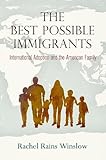The Best Possible Immigrants : International Adoption and the American Family / Rachel Rains Winslow.
Material type: TextSeries: Politics and Culture in Modern AmericaPublisher: Philadelphia : University of Pennsylvania Press, [2017]Copyright date: ©2017Description: 1 online resource (344 p.) : 6 illusContent type:
TextSeries: Politics and Culture in Modern AmericaPublisher: Philadelphia : University of Pennsylvania Press, [2017]Copyright date: ©2017Description: 1 online resource (344 p.) : 6 illusContent type: - 9780812293968
- Intercountry adoption -- Government policy -- United States -- History -- 20th century
- Intercountry adoption -- United States -- History -- 20th century
- Interracial adoption -- United States -- History -- 20th century
- American History
- American Studies
- Political Science
- Public Policy
- HISTORY / United States / 20th Century
- HV875.5 .W567 2017
- online - DeGruyter
| Item type | Current library | Call number | URL | Status | Notes | Barcode | |
|---|---|---|---|---|---|---|---|
 eBook
eBook
|
Biblioteca "Angelicum" Pont. Univ. S.Tommaso d'Aquino Nuvola online | online - DeGruyter (Browse shelf(Opens below)) | Online access | Not for loan (Accesso limitato) | Accesso per gli utenti autorizzati / Access for authorized users | (dgr)9780812293968 |
Frontmatter -- Contents -- List of Abbreviations -- Introduction. The Interest of Many: The Foundations of International Adoption -- Chapter 1. “Babyselling Rings,” “Adoption Mills,” and “Baby Rackets”: Formalizing Policies and Manufacturing Markets -- Chapter 2. “An International Baby Hunt”: The “Gray Market” in Greece -- Chapter 3. “The Great Heart of America”: Volunteer Humanitarians and Korean Adoptions -- Chapter 4. Coming Out of the Shadows: Adoptive Parents as Public Figures -- Chapter 5. A New Kind of Racial Alchemy: International Development, Transracial Adoption, and the Vietnam War -- Chapter 6. “Children of Controversy”: Operation Babylift and the Crisis of Humanitarianism -- Epilogue. The Legacy of Voluntarism: International Adoption in the Twenty-First Century -- Appendix. Selected Immigration Legislation and Refugee Action Chronology, 1945–1976 -- Notes -- Select Bibliography -- Index -- Acknowledgments
restricted access online access with authorization star
http://purl.org/coar/access_right/c_16ec
Prior to World War II, international adoption was virtually unknown, but in the twenty-first century, it has become a common practice, touching almost every American. How did the adoption of foreign children by U.S. families become an essential part of American culture in such a short period of time? Rachel Rains Winslow investigates this question, following the trail from Europe to South Korea and then to Vietnam. Drawing on a wide range of political and cultural sources, The Best Possible Immigrants shows how a combination of domestic trends, foreign policies, and international instabilities created an environment in which adoption flourished.Winslow contends that international adoption succeeded as a long-term solution to child welfare not because it was in the interest of one group but because it was in the interest of many. Focusing on the three decades after World War II, she argues that the system came about through the work of governments, social welfare professionals, volunteers, national and local media, adoptive parents, and prospective adoptive parents. In her chronicle, Winslow not only reveals the diversity of interests at play but also shows the underlying character of the U.S. social welfare state and international humanitarianism. In so doing, she sheds light on the shifting ideologies of family in the postwar era, underscoring the important cultural work at the center of policy efforts and state projects. The Best Possible Immigrants is a fascinating story about the role private citizens and organizations played in adoption history as well as their impact on state-formation, lawmaking, and U.S. foreign policy.
Mode of access: Internet via World Wide Web.
In English.
Description based on online resource; title from PDF title page (publisher's Web site, viewed 26. Aug 2020)


